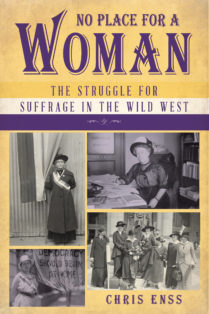Enter now to win a copy of the new book
No Place for a Woman: The Fight for Suffrage in the Wild West.

On September 18, 1909, Laura Gregg of the Arizona Equal Suffrage Campaign Committee rolled a sheet of letterhead into her typewriter and began an affectionate letter to Anna Howard Shaw, president of the National American Woman Suffrage Association. Shaw, who had been injured in an accident, was recuperating in Minneapolis, and Gregg wrote to her:
“If I had known that you were roasting on a bed of suffering in Minneapolis, I should certainly have sent you a little love note, as well as to send you all of the helpful thoughts that I could. At this late date, however, it is not too late to tell you how much I rejoice that your recovery has been so speedy, and that through it all you have had such Spartan courage to do such wonderful things as I am reading about, while you must have been suffering so much.”
Shaw, as head of the biggest national organization promoting woman suffrage, had been traveling the country stumping for the cause and speaking from her heart to the state organizations that had sprung up in nearly every state and territory. She had won the hearts of her fellow suffragists with her warm and intelligent rhetoric and open attitudes. And while she was working on the national stage, organizations like the Arizona Equal Suffrage Campaign Committee were going into homes, posing legal arguments, asking questions, and changing minds.
In the late nineteenth and early twentieth centuries, as the territorial governments of the West formed and territorial laws were established, and then as territories made the move into statehood, suffrage advocates across the country had their eyes on the opportunities that came with crafting the law of the land from the ground up. If women hadn’t been excluded from the vote by law in each territory, went the reasoning, they didn’t need to be under the new laws and statutes that were being written.
After the Civil War, the discussion about women and the vote had been firmly on the political table for almost two decades. Women all over the United States had been protesting, lobbying, and had even been arrested for attempting to vote in elections. Pressure grew, as early as the 1870s, for a national suffrage amendment in Congress. But faced with great opposition—or apathy—on a nationwide scale, many suffrage advocates saw the laws being written on the frontier as the best chance for the vote to take hold in law.

To learn more about how women won the right to vote in the West read
No Place for a Woman

